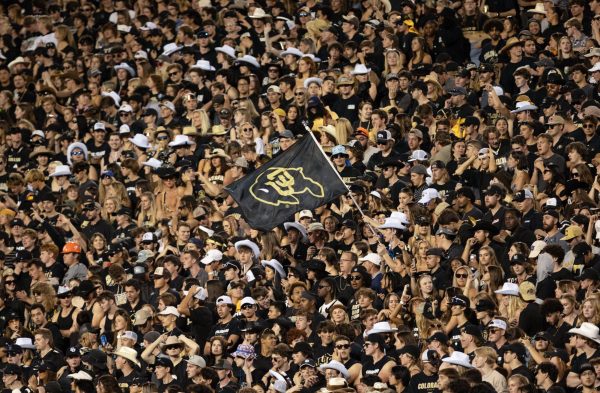Global Village Museum celebrates Día de los Muertos with exhibition
Collegian | Staff Photographer
Two skeletons dressed in bride and groom wedding attire sit at a table with fake fruit and a bottle of wine for Dia de los Muertos at Global Village Museum of Arts and Cultures Oct. 22. The skeletons represented life after death.
Zoe Hayman
November 1, 2022
Honoring loved ones who have died can be a somber experience for some. For others it can be a time for commemoration and celebration of the lives they once lived.
Beginning earlier this month and until Nov. 19, the Global Village Museum of Arts and Cultures is presenting a “Día de Muertos,” or Day of the Dead, exhibition. It showcases ofrendas — or altars — in celebration of the Mexican holiday.
“Part of Día de los Muertos is making death less scary for kids and people so that it’s fun and you get to see your family members again,” said Ollie Bode, collections manager and volunteer coordinator at the Global Village Museum.
Día de los Muertos is generally celebrated Nov. 1-2. Día de los Muertos originated in Mexico and is now recognized in many Latin American countries as well as the United States.
“It’s become a lot more celebrated in the United States, outside of traditional just Mexican American households,” Bode said.
The halls of the Global Village Museum are filled with altars decorated with pictures and flowers to honor loved ones who have died.
“It’s fun, and it’s family, and it’s a celebration, so death doesn’t have to be this scary thing, which sometimes it can be in U.S. culture,” Bode said.
Bode emphasized community involvement within the exhibition.
“Ours is more of a community experience — less traditional,” Bode said.
Having only done the exhibit a couple times in the past, the participation level is high.
Local schools play a big role in making the altars. Schools involved include Laurel Elementary, Coyote Ridge Elementary, Boltz Middle School, Mountain Sage Community School and the Fort Collins High School Latin American Student Alliance.
Sebastian Chiru, an intern for the Global Village Museum, commented on the hard work put into constructing the ofrendas.
“I think it’s pretty important to know a lot of the high schools and middle schools spent a lot of time coming here and kind of incorporating their own style of trying to celebrate the Day of the Dead,” Chiru said. “I find it amazing, actually, how these kids who are 14, 15 (or) 16 years old (are) coming in and just doing an amazing job.”
The Pride Resource Center at Colorado State University was another community group who showed support by getting involved. Members of the club created an altar for Frida Kahlo and Chavela Vargas.
Putting together the altars offers insight as well as a learning experience for students.
“It lets kids learn a different way of looking at death and honoring their family members,” Bode said.
Día de los Muertos ofrendas are set up to make the souls of loved ones feel welcomed and to show them their way back home. They are decorated with marigolds (flowers of the dead), calavera (sugar skulls), candles, photographs and more to honor the deceased.
“People have been really intrigued, and they want to know what it’s about,” Bode said.
Before this year’s Día de los Muertos is over, make sure to visit the exhibition and learn more about the holiday.
Reach Emmalee Krieg at entertainment@collegian.com or on Twitter @CSUCollegian.







